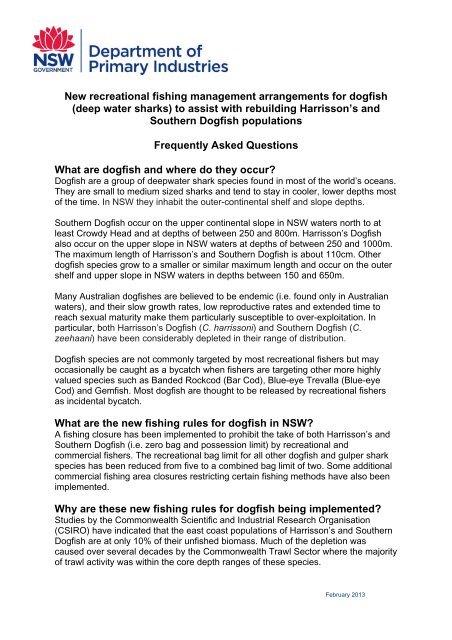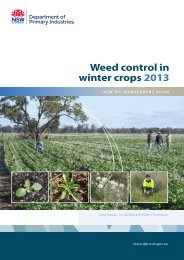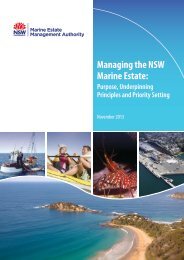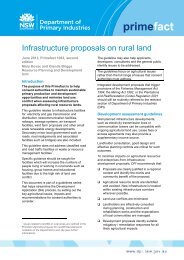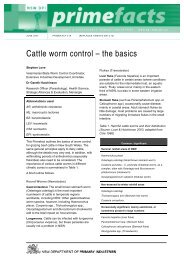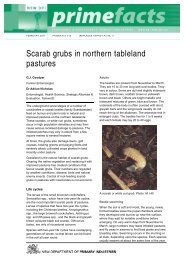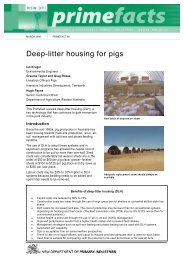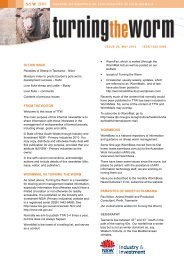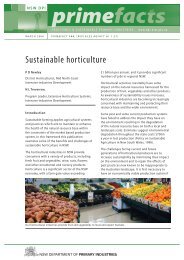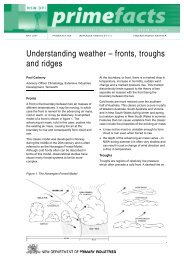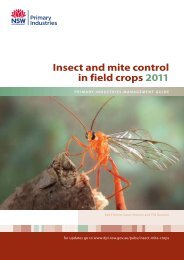Frequently Asked Questions - NSW Department of Primary Industries
Frequently Asked Questions - NSW Department of Primary Industries
Frequently Asked Questions - NSW Department of Primary Industries
Create successful ePaper yourself
Turn your PDF publications into a flip-book with our unique Google optimized e-Paper software.
New recreational fishing management arrangements for dogfish<br />
(deep water sharks) to assist with rebuilding Harrisson’s and<br />
Southern Dogfish populations<br />
<strong>Frequently</strong> <strong>Asked</strong> <strong>Questions</strong><br />
What are dogfish and where do they occur?<br />
Dogfish are a group <strong>of</strong> deepwater shark species found in most <strong>of</strong> the world’s oceans.<br />
They are small to medium sized sharks and tend to stay in cooler, lower depths most<br />
<strong>of</strong> the time. In <strong>NSW</strong> they inhabit the outer-continental shelf and slope depths.<br />
Southern Dogfish occur on the upper continental slope in <strong>NSW</strong> waters north to at<br />
least Crowdy Head and at depths <strong>of</strong> between 250 and 800m. Harrisson’s Dogfish<br />
also occur on the upper slope in <strong>NSW</strong> waters at depths <strong>of</strong> between 250 and 1000m.<br />
The maximum length <strong>of</strong> Harrisson’s and Southern Dogfish is about 110cm. Other<br />
dogfish species grow to a smaller or similar maximum length and occur on the outer<br />
shelf and upper slope in <strong>NSW</strong> waters in depths between 150 and 650m.<br />
Many Australian dogfishes are believed to be endemic (i.e. found only in Australian<br />
waters), and their slow growth rates, low reproductive rates and extended time to<br />
reach sexual maturity make them particularly susceptible to over-exploitation. In<br />
particular, both Harrisson’s Dogfish (C. harrissoni) and Southern Dogfish (C.<br />
zeehaani) have been considerably depleted in their range <strong>of</strong> distribution.<br />
Dogfish species are not commonly targeted by most recreational fishers but may<br />
occasionally be caught as a bycatch when fishers are targeting other more highly<br />
valued species such as Banded Rockcod (Bar Cod), Blue-eye Trevalla (Blue-eye<br />
Cod) and Gemfish. Most dogfish are thought to be released by recreational fishers<br />
as incidental bycatch.<br />
What are the new fishing rules for dogfish in <strong>NSW</strong>?<br />
A fishing closure has been implemented to prohibit the take <strong>of</strong> both Harrisson’s and<br />
Southern Dogfish (i.e. zero bag and possession limit) by recreational and<br />
commercial fishers. The recreational bag limit for all other dogfish and gulper shark<br />
species has been reduced from five to a combined bag limit <strong>of</strong> two. Some additional<br />
commercial fishing area closures restricting certain fishing methods have also been<br />
implemented.<br />
Why are these new fishing rules for dogfish being implemented?<br />
Studies by the Commonwealth Scientific and Industrial Research Organisation<br />
(CSIRO) have indicated that the east coast populations <strong>of</strong> Harrisson’s and Southern<br />
Dogfish are at only 10% <strong>of</strong> their unfished biomass. Much <strong>of</strong> the depletion was<br />
caused over several decades by the Commonwealth Trawl Sector where the majority<br />
<strong>of</strong> trawl activity was within the core depth ranges <strong>of</strong> these species.<br />
February 2013
Most <strong>of</strong> the remnant populations are now found on the seamounts <strong>of</strong>f the <strong>NSW</strong><br />
coast, and in <strong>NSW</strong>-managed waters between Wollongong and Port Macquarie.<br />
Harrisson’s, Southern and Endeavour Dogfish were previously nominated for listing<br />
under the Commonwealth Environment Protection and Biodiversity Conservation Act<br />
1999 (EPBC Act). A number <strong>of</strong> targeted commercial fishing area closures were<br />
subsequently implemented by the Australian Fisheries Management Authority<br />
(AFMA) in 2010 in waters where it has jurisdiction as part <strong>of</strong> its ‘Upper-slope dogfish<br />
management strategy’ to assist with the rebuilding <strong>of</strong> dogfish populations. <strong>NSW</strong> DPI<br />
also implemented a complementary closure to certain commercial fishing methods in<br />
an area <strong>of</strong>f Sydney in April 2011.<br />
However later in 2011 the Commonwealth <strong>Department</strong> <strong>of</strong> Sustainability,<br />
Environment, Water, Populations and Communities reviewed the area closures in<br />
place and considered these closures were not sufficient to ensure the recovery <strong>of</strong> the<br />
relevant dogfish species. Since that time, the Commonwealth Environment Minister<br />
decided not to list the Endeavour Dogfish as a threatened species, however<br />
additional protection measures are still needed to address the significant depletion <strong>of</strong><br />
Harrisson’s and Southern Dogfish populations.<br />
Both <strong>NSW</strong> DPI and the Australian Fisheries Management Authority (AFMA) have<br />
been working together on collaborative strategies to address the risks posed by each<br />
jurisdiction’s fisheries on Harrisson’s and Southern Dogfish. The AFMA Upper-Slope<br />
Dogfish Management Strategy has since been further strengthened to promote the<br />
recovery <strong>of</strong> Harrisson’s and Southern Dogfish. While the new strategy relates<br />
primarily to Harrisson’s and Southern Dogfish, it also provides additional protection<br />
to Endeavour Dogfish and Greeneye Spurdogs.<br />
The new fishing rules as part <strong>of</strong> the <strong>NSW</strong> strategy prohibit the take <strong>of</strong> Harrisson’s<br />
and Southern Dogfish by commercial and recreational fishers. Some additional<br />
commercial fishing area closures restricting certain fishing methods have also been<br />
implemented (for more detail go to: www.dpi.nsw.gov.au).<br />
The strategy also takes account <strong>of</strong> the inherent vulnerability <strong>of</strong> other dogfish species<br />
given their general biology and life history (e.g. slow growth rate, low fecundity, etc.).<br />
To provide additional protection for these other dogfish species, the recreational bag<br />
limit for these species has also been reduced from five to a combined limit <strong>of</strong> two.<br />
Were any alternative arrangements considered?<br />
Yes. One such option proposed by the Commonwealth included a series <strong>of</strong> deep<br />
water area fishing closures (e.g. one large area was near Browns Mountain <strong>of</strong>f<br />
Sydney). These proposed closures areas would have involved zero take for all<br />
dogfish species but also all other fish, including highly desirable species such as<br />
Banded Rockcod (Bar Cod), Blue-eye Trevalla (Blue-eye Cod) and Gemfish. This<br />
proposal would have had significant impacts on recreational and charter fishing in<br />
<strong>NSW</strong>.<br />
A zero take for Harrisson’s Dogfish and Southern Dogfish and a reduced combined<br />
bag limit for other dogfish species were considered the most suitable arrangement<br />
for recreational fishers, which would impact on the activities <strong>of</strong> few anglers.<br />
However, anglers need to take a keen interest in this issue and do their part by<br />
learning how to identify the different dogfish species, move away from an area if you
incidentally catch a Harrisson’s or Southern Dogfish while fishing for other species,<br />
and to release any such individuals taken immediately and with the greatest care<br />
possible.<br />
What do these dogfish species look like?<br />
Dogfish species guides are included at the end <strong>of</strong> this document. The primary<br />
distinguishing features <strong>of</strong> each species are highlighted in orange. To obtain waterresistant<br />
copies <strong>of</strong> these guides, please contact <strong>NSW</strong> DPI on (02) 9741 4712 or<br />
email: fisheries.recoveryprograms@dpi.nsw.gov.au.<br />
These guides have been extracted from the <strong>NSW</strong> DPI publication titled ‘Identifying<br />
sharks and rays.’ The full publication can be found at:<br />
www.dpi.nsw.gov.au/fisheries/commercial/fisheries/otl-fishery/identifying-sharks-andrays.<br />
What if I am unsure about identifying different dogfish species?<br />
If you catch a dogfish and are unsure about what species you have caught, DPI<br />
encourages you release it carefully and immediately.<br />
Some tips on how to maximise a fish's survival when catching and releasing fish<br />
include:<br />
• If the fish is hooked deeply, cut the line as close as possible to the fish’s mouth<br />
rather than removing the hook. Remove hooks from mouth-hooked fish.<br />
• Minimise the length <strong>of</strong> time the fish is out <strong>of</strong> the water<br />
• Ideally unhook fish while it is still in the water<br />
• Try to remove hooks and release fish as quickly as possible<br />
• The use <strong>of</strong> needle-nosed pliers or hook retrieving devices can greatly reduce time<br />
spent unhooking<br />
• Use methods and rigs that increase the frequency <strong>of</strong> mouth hooked fish<br />
• Use fish-friendly landing nets with s<strong>of</strong>t knotless mesh. Knotted landing nets may<br />
damage the fish’s scales, skin, eyes and fins<br />
• Handle fish firmly and carefully. Avoid dropping fish onto the bottom <strong>of</strong> boats and<br />
other hard surfaces.<br />
• Use wet hands or wet gloves when handling fish to minimise damage to its skin.<br />
• A smooth, wet surface or vinyl covered foam is the most suitable surface to place<br />
fish on in order to remove hooks. Remember, many surfaces, especially metal,<br />
can become very hot in the sun.<br />
• Do not hold fish by the gills or the eyes.<br />
• Take care to revive fish upon release if they appear exhausted (struggling to hold<br />
themselves upright and/or unable to swim away)<br />
• Gently hold or push the fish through the water so that it obtains a good flow <strong>of</strong><br />
water over its gills. If there is any water current, hold the fish upright facing<br />
towards the current until it starts to show signs <strong>of</strong> recovery.<br />
More information on catch and release can be found at:<br />
www.dpi.nsw.gov.au/fisheries/recreational/info/catch-and-release
Southern dogfish<br />
(Centrophorus zeehaani)<br />
<strong>NSW</strong> DPI code:<br />
SHK-21<br />
no interdorsal ridge<br />
4<br />
1<br />
3<br />
3<br />
precaudal pit<br />
present<br />
5<br />
2<br />
Distinguishing features<br />
• No interdorsal ridge • No distinct black tips on fins<br />
1 Prominent spines extending from 1st and 2nd dorsal fin origins<br />
2 Trailing edge <strong>of</strong> tail with notch (or flap) – i.e. not smoothly rounded<br />
3 Height <strong>of</strong> 2nd dorsal fin at least two-thirds that <strong>of</strong> the 1st dorsal fin<br />
4 Small white spot in the middle <strong>of</strong> the upper surface <strong>of</strong> the snout<br />
• Distance from snout tip to front corner <strong>of</strong> eye equal or slightly less<br />
than distance from front corner <strong>of</strong> eye to the spiracle<br />
5 No anal fin<br />
Colouration<br />
• Upper body light brown in adults, grey in juveniles; pale underside<br />
• Tips and trailing edges <strong>of</strong> dorsal fins can be dark, but much less so in<br />
adults<br />
• Usually a small white spot in the middle <strong>of</strong> the upper surface <strong>of</strong> the snout<br />
Size & Distribution<br />
• Born ~ 40 cm; males max. ~ 90 cm; females max. ~110 cm<br />
• Demersal on upper slope in <strong>NSW</strong> waters north to at least Crowdy Head,<br />
and at depths <strong>of</strong> between 250 and 800 m<br />
36
Harrisson’s dogfish<br />
(Centrophorus harrissoni)<br />
<strong>NSW</strong> DPI code:<br />
SHK-22<br />
no interdorsal ridge<br />
4<br />
1<br />
3<br />
3<br />
precaudal pit<br />
present<br />
5<br />
2<br />
Distinguishing features<br />
• No interdorsal ridge • No distinct black tips on fins<br />
1 Prominent spines extending from 1st and 2nd dorsal fin origins<br />
2 Trailing edge <strong>of</strong> tail with notch (or flap) – i.e. not smoothly rounded<br />
3 Height <strong>of</strong> 2nd dorsal fin at least two-thirds that <strong>of</strong> the 1st dorsal fin<br />
4 No small white spot in middle <strong>of</strong> upper surface <strong>of</strong> snout<br />
• Distance from the snout tip to the front corner <strong>of</strong> eye noticeably<br />
greater (about 1.4 x) than the distance from front corner <strong>of</strong> the eye to<br />
the spiracle<br />
5 No anal fin<br />
Colouration<br />
• Light-greyish or brownish upper body; pale underside<br />
• Tail mostly greyish with a slightly darker posterior half <strong>of</strong> tail-flaps<br />
• Upper front <strong>of</strong> dorsal fins with dark patch; less obvious in adults<br />
• Often a dark smudge around the bases <strong>of</strong> dorsal fins<br />
Size & Distribution<br />
• Born ~ 40 cm; males max. ~ 95 cm; females max. ~ 110 cm.<br />
• Demersal on upper slope in <strong>NSW</strong> waters north to at least C<strong>of</strong>fs Harbour,<br />
and at depths <strong>of</strong> between 250 and 1000 m<br />
37
Endeavour dogfish<br />
(Centrophorus moluccensis)<br />
<strong>NSW</strong> DPI code:<br />
SHK-23<br />
4<br />
1<br />
3<br />
no interdorsal ridge<br />
3<br />
precaudal pit<br />
present<br />
5<br />
2<br />
Distinguishing features<br />
• No interdorsal ridge<br />
• No distinct black tips on fins<br />
1 Prominent spines extending from 1st and 2nd dorsal fin origins<br />
2 Trailing edge <strong>of</strong> tail with notch (or flap) – i.e. not smoothly rounded<br />
3 Height <strong>of</strong> 2nd dorsal fin about half that <strong>of</strong> the 1st dorsal fin<br />
4 No small white spot in middle <strong>of</strong> upper surface <strong>of</strong> snout<br />
5 No anal fin<br />
Colouration<br />
• Light-greyish or brownish upper body; pale underside<br />
• Tail mostly greyish with a pale trailing edge<br />
• Smaller individuals with dark blotches near the tip <strong>of</strong> the 1st dorsal fin<br />
Size & Distribution<br />
• Born ~ 40 cm; males max. ~ 85 cm; females max. ~ 95 cm<br />
• Demersal on outer shelf and upper slope in <strong>NSW</strong> waters at between<br />
150 and 650 m depth<br />
38
Dark-tailed dogfishes<br />
Greeneye dogfish - Squalus choloroculus<br />
Northern greeneye dogfish - Squalus montalbani<br />
Eastern longnose dogfish - Squalus grahami<br />
<strong>NSW</strong> DPI code:<br />
SHK-19<br />
This example:<br />
Northern greeneye dogfish<br />
1<br />
no interdorsal ridge<br />
precaudal pit<br />
present<br />
2<br />
4<br />
3<br />
Distinguishing features<br />
• No interdorsal ridge<br />
• No distinct black tips on fins<br />
1 Prominent spines extending from 1st and 2nd dorsal fin origins<br />
2 Trailing edge <strong>of</strong> tail smoothly rounded and without sub-apical notch<br />
3 Obvious but smudgy dark patch on the tail and at the centre <strong>of</strong> its<br />
trailing edge<br />
4 Slender-bodied shark; anal fin absent<br />
• Dorsal fins grey and commonly with slightly darker tip and trailing edge<br />
Colouration<br />
• Dark grey upper body; pale to white underside<br />
• Tail mostly greyish with a broad darkish area along the centre the<br />
trailing edge<br />
• Tips <strong>of</strong> upper and lower lobes <strong>of</strong> tail whitish<br />
Size & Distribution<br />
• Born ~ 20 cm; max. ~ 110 cm<br />
• Demersal on outer shelf and upper slope in <strong>NSW</strong> waters at between<br />
150 and 600 m depth<br />
34
White-tailed dogfishes<br />
Spiky dogfish - Squalus megalops<br />
Eastern highfin dogfish - Squalus albifrons<br />
This example:<br />
Spiky dogfish<br />
<strong>NSW</strong> DPI code:<br />
SHK-20<br />
1<br />
no interdorsal ridge<br />
precaudal pit<br />
present<br />
2<br />
4<br />
3<br />
Distinguishing features<br />
• No interdorsal ridge<br />
• No distinct black tips on fins<br />
1 Prominent spines extending from 1st and 2nd dorsal fin origins<br />
2 Trailing edge <strong>of</strong> tail smoothly rounded and without sub-apical notch<br />
3 No dark patch on the tail – entire trailing edge <strong>of</strong> tail pale or white<br />
4 Slender-bodied shark; anal fin absent<br />
• Upper margins <strong>of</strong> dorsal fins may be slightly dark<br />
Colouration<br />
• Pale-greyish to brownish upper body; pale/white underside<br />
• Tail mostly greyish with a white or very pale trailing edge<br />
Size & Distribution<br />
• Born ~ 20 cm; max. ~ 90 cm<br />
• Demersal on outer shelf and upper slope in <strong>NSW</strong> waters at between<br />
150 and 400 m depth<br />
35
Identifying parts <strong>of</strong> the shark<br />
fin origin<br />
1st<br />
dorsal fin<br />
Interdorsal ridge<br />
upper<br />
precaudal pit<br />
2nd<br />
dorsal fin<br />
upper<br />
tail lobe<br />
gill slits<br />
free rear tips<br />
pectoral fins<br />
pelvic fins<br />
anal fin<br />
caudal<br />
(tail) fin<br />
lower tail lobe<br />
snout<br />
‘dusky’ tipped<br />
‘dipped in paint’<br />
SHAPE OF SNOUT<br />
nostril<br />
mouth<br />
blunt<br />
short and<br />
rounded<br />
long and<br />
rounded<br />
pointed<br />
7
KEY 1: Whaler sharks and other sharks <strong>of</strong> similar appearance to whalers – upper precaudal pit present<br />
Stripey pattern on body; distinctive teeth with one<br />
edge deeply notched and the other strongly curved<br />
No<br />
White tips on 1st dorsal<br />
and pectoral fins<br />
Yes<br />
INTERDORSAL RIDGE<br />
No<br />
Yes<br />
No<br />
Yes<br />
Distinct black tips on most fins *<br />
Oceanic whitetip<br />
shark<br />
(p18)<br />
Yes<br />
No<br />
Tiger shark<br />
(p19)<br />
KEY 1<br />
Anal fin looks like it has been dipped<br />
in black paint; and teeth are quite<br />
small for the size <strong>of</strong> the shark<br />
1st dorsal fin origin well forward <strong>of</strong> the<br />
free rear tips <strong>of</strong> the pectoral fins<br />
Yes<br />
No<br />
Yes No<br />
Upper teeth broad and triangular with<br />
gently-curving, serrated edges<br />
Height <strong>of</strong> the 1st dorsal fin<br />
greater than half the length<br />
between the 1st dorsal fin<br />
origin and the tip <strong>of</strong> the snout<br />
Spinner<br />
shark<br />
(p21)<br />
Common blacktip<br />
shark<br />
(p20)<br />
Yes No<br />
Yes No<br />
Note that common blacktip sharks <strong>of</strong><br />
sizes larger than about 130 m long<br />
may lack fin markings<br />
*<br />
Silky shark<br />
(p17)<br />
Dusky whaler<br />
(p16)<br />
Bignose<br />
shark<br />
(p15)<br />
Sandbar<br />
shark<br />
(p14)<br />
In such cases the teeth are the best<br />
distinguishing feature<br />
8
KEY 1 continued<br />
Spines extending from 1st and 2nd dorsal fin origins<br />
Yes<br />
No<br />
Height <strong>of</strong> the 2nd<br />
dorsal fin at least<br />
half that <strong>of</strong> the<br />
1st dorsal fin<br />
Yes 2nd dorsal fin origin closer to pelvic<br />
fin free rear tips than to anal fin origin<br />
No<br />
Yes<br />
Notched trailing edge<br />
<strong>of</strong> upper lobe <strong>of</strong> the<br />
tail rather than<br />
smoothly curved<br />
Yes<br />
Height <strong>of</strong> the 2nd<br />
dorsal fin more than<br />
two-thirds the height<br />
<strong>of</strong> the1st dorsal fin<br />
Yes<br />
Tail with smudgy dark patch<br />
on it and its trailing edge<br />
Yes<br />
Dark-tailed<br />
dogfishes<br />
(p34)<br />
Small white/pale spot in the middle <strong>of</strong> the<br />
upper surface <strong>of</strong> the head<br />
Yes<br />
No<br />
No<br />
No<br />
Endeavour<br />
dogfish<br />
(p38)<br />
No<br />
White-tailed<br />
dogfishes<br />
(p35)<br />
Length <strong>of</strong> pectoral<br />
fins greater than<br />
twice the height <strong>of</strong><br />
the 1st dorsal fin<br />
Yes No<br />
Yes<br />
No<br />
1st dorsal fin<br />
origin well<br />
behind the free<br />
rear tips <strong>of</strong> the<br />
pectoral fins<br />
No<br />
Upper teeth broad and<br />
triangular with quite<br />
straight, serrated edges<br />
Yes No<br />
Upper teeth with one edge<br />
coarsely-serrated (comb-like)<br />
and the other edge smooth<br />
Yes No<br />
Weasel shark<br />
(p26)<br />
Lemon shark<br />
(p27)<br />
1st and 2nd dorsal fins<br />
the same size and<br />
brown spots on body<br />
Yes No<br />
Blue<br />
Sliteye<br />
Grey nurse<br />
Sandtiger<br />
Southern dogfish Harrisson's dogfish shark shark Bull shark Bronze whaler shark shark<br />
(p36) (p37) (p22) (p23) (p24) (p25) (p28) (p29)<br />
9


